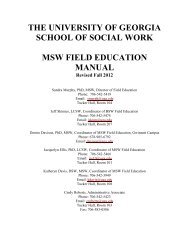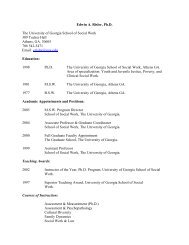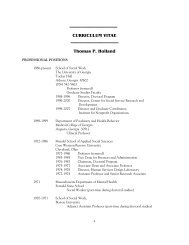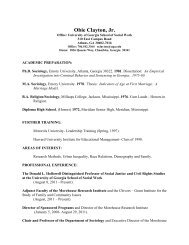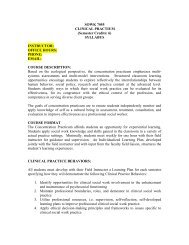Developing Self-Efficacy in MSW Students Through Service-Learning
Developing Self-Efficacy in MSW Students Through Service-Learning
Developing Self-Efficacy in MSW Students Through Service-Learning
Create successful ePaper yourself
Turn your PDF publications into a flip-book with our unique Google optimized e-Paper software.
10 th International Conference on Urban Dra<strong>in</strong>age, Copenhagen/Denmark, 21-26 August 2005organisation, as each scientific partner is <strong>in</strong> charge of the cont<strong>in</strong>uous contact with local endusers;this means numerous rem<strong>in</strong>ders via e-mail and telephone to the local partners. Thedelays caused by the difficulties <strong>in</strong> f<strong>in</strong>d<strong>in</strong>g common meet<strong>in</strong>g dates for partner and end-users,seem to be m<strong>in</strong>or <strong>in</strong> national terms, but are accumulat<strong>in</strong>g at the project scale and result <strong>in</strong>difficulties <strong>in</strong> terms of project progress.On the other side, end-users compla<strong>in</strong> not to be sufficiently <strong>in</strong>formed on the overall projectadvancement. It was stated that the bi-annual DayWater newsletter does not conta<strong>in</strong> enoughdetailed <strong>in</strong>formation and therefore does not replace a regular contact between the nationalscientific partner and the end-users, which demands availabilities on both sides. Despite<strong>in</strong>vit<strong>in</strong>g all CEU to the annual project meet<strong>in</strong>gs and present<strong>in</strong>g them the demonstrations of allavailable ADSS components, their knowledge about the DayWater project is often limited tothe component developed by their respective national scientific partner.Common def<strong>in</strong>ition of ADSS structure and functionalitiesThe <strong>in</strong>tr<strong>in</strong>sic difficulties of a multidiscipl<strong>in</strong>ary and mult<strong>in</strong>ational project are obvious. First ofall, even when scientific partners were work<strong>in</strong>g <strong>in</strong> the same field, there is a common languageto be found for the project <strong>in</strong>herent terms. It took a long time before every partner becameaware of such language problems. Such misunderstand<strong>in</strong>gs were both related to the commonuse of the English language, and to different cultural approaches, such as the way to beunderstood outside the scientific field. Different professional backgrounds may causedifferent def<strong>in</strong>ition of technical and trivial terms. Nearly all partners have experience <strong>in</strong><strong>in</strong>ternational projects and should therefore be aware of these k<strong>in</strong>ds of problems, but there isstill a gap between the simple knowledge of the existence of these problems and the realisedawareness and result<strong>in</strong>g behaviour. A cautious behaviour means verification of e-mails orreports directly with the responsible person, <strong>in</strong> case of seem<strong>in</strong>gly offensive statements. Thereis clearly a lack of understand<strong>in</strong>g to be stated, which might be due to little will<strong>in</strong>gness, towork overload or to ignorance of <strong>in</strong>tercultural differences. Thus the personal encounters,dur<strong>in</strong>g numerous work meet<strong>in</strong>gs, were found necessary for the success of the DayWaterdevelopment.Development of ADSS componentsThe ambition and expectations on the ADSS prototype were differ<strong>in</strong>g a lot dur<strong>in</strong>g the firsttwo project years. At the beg<strong>in</strong>n<strong>in</strong>g of the project, it was difficult to have a realistic frame ofall the <strong>in</strong>teractions <strong>in</strong> the project due to its complexity. Each partner developed “his”components mostly <strong>in</strong>dependent to the other components and their mutual requirements. TheToR of the ADSS was expected to remediate this problem, demand<strong>in</strong>g every componentdeveloper to describe his requirements and his contribution to the other components and to thegeneral ADSS structure. The partners felt not able to do so, as the <strong>in</strong>ter-relations were onlydiscovered step by step, parallel to their development. This is <strong>in</strong> contradiction to the functionof the ToR, which should be the reference document to the prototype development.Furthermore the <strong>in</strong>itial work plan did not specifically mention the dates of delivery of eachADSS component. This omission made it difficult to make each partner understand theconsequences, caused by delays with<strong>in</strong> elaboration of their component specification andimplementation <strong>in</strong> the Web based ADSS tool.Attention to decision-mak<strong>in</strong>g proceduresThe analysis of the decision-mak<strong>in</strong>g process (DMP) <strong>in</strong> USWM projects is a good example forthis <strong>in</strong>tercultural and <strong>in</strong>terdiscipl<strong>in</strong>ary misunderstand<strong>in</strong>g (Deutsch et al., 2004). Consultanteng<strong>in</strong>eers conceive the DMP <strong>in</strong> a different way than researchers and south European countriesdo not consider the DMP as north Europeans do. Thus it was found necessary to <strong>in</strong>tegrate, <strong>in</strong>D. Thévenot & M. Förster 5



